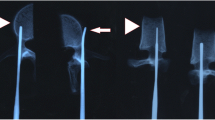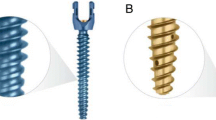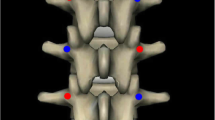Abstract
Background
The objective of this cadaveric study was to analyze the effects of iatrogenic pedicle perforations from screw misplacement on the mean pullout strength of lower thoracic and lumbar pedicle screws. We also investigated the effect of bone mineral density (BMD), diameter of pedicle screws, and the region of spine on the pullout strength of pedicle screws.
Materials and Methods
Sixty fresh human cadaveric vertebrae (D10-L2) were harvested. Dual-energy X-ray absorptiometry (DEXA) scan of vertebrae was done for BMD. Titanium pedicle screws of different diameters (5.2 and 6.2 mm) were inserted in the thoracic and lumbar segments after dividing the specimens into three groups: a) standard pedicle screw (no cortical perforation); b) screw with medial cortical perforation; and c) screw with lateral cortical perforation. Finally, pullout load of pedicle screws was recorded using INSTRON Universal Testing Machine.
Results
Compared with standard placement, medially misplaced screws had 9.4% greater mean pullout strength and laterally misplaced screws had 47.3% lesser mean pullout strength. The pullout strength of the 6.2 mm pedicle screws was 33% greater than that of the 5.2 mm pedicle screws. The pullout load of pedicle screws in lumbar vertebra was 13.9% greater than that in the thoracic vertebra (P = 0.105), but it was not statistically significant. There was no significant difference between pullout loads of vertebra with different BMD (P = 0.901).
Conclusion
The mean pullout strength was less with lateral misplaced pedicle screws while medial misplaced pedicle screw had more pullout strength. The pullout load of 6.2 mm screws was greater than that of 5.2 mm pedicle screws. No significant correlation was found between bone mineral densities and the pullout strength of vertebra. Similarly, the pullout load of screw placed in thoracic and lumbar vertebrae was not significantly different.
Similar content being viewed by others
References
Roy-Camille R, Saillant G, Mazel C. Internal fixation of the lumbar spine with pedicle screw plating. Clin Orthop Rel Res 1986;203:7–17.
Brasiliense LB, Theodore N, Lazaro BC, Sayed ZA, Deniz FE, Sonntag VK, et al. Quantitative analysis of misplaced pedicle screws in the thoracic spine: How much pullout strength is lost? J Neurosurg Spine 2010;12:503–8.
George DC, Krag MH, Johnson CC, Van Hal ME, Haugh LD, Grobler LJ. Hole preparation techniques for transpedicle screws. Effect on pull-out strength from human cadaveric vertebrae. Spine (Phila Pa 1976) 1991;16:181–4.
Kote R, Panjabi MM, Liu W. Multidirectional instability of the thoracic spine due to iatrogenic pedicle injuries during transpedicular fixation. Spine 1997;22:1836–42.
Wittenberg RH, Lee KS, Shea M, White AA 3rd, Hayes WC. Effect of screw diameter, insertion technique, and bone cement augmentation of pedicular screw fixation strength. Clin Orthop Rel Res 1993;296:278–87.
Hirano T, Hasegawa K, Takahashi HE, Uchiyama S, Hara T, Washio T. Structural characteristics of the pedicle and its role in screw stability. Spine (Phila Pa 1976) 1997;22:2504–10.
Misenhimer GR, Peek RD, Wiltse LL, Rothman SL, Widell EH Jr. Anatomic analysis of pedicle cortical and cancellous diameter as related to screw size. Spine (Phila Pa 1976) 1989;14:367–72.
Kothe R, O’Holleran JD, Liu W, Panjabi MM. Internal architecture of the thoracic pedicle. An anatomic study. Spine (Phila Pa 1976) 1996;21:264–70.
Inceoglu S, Burghardt A, Akbay A, Majumdar S, McLain RF. Trabecular architecture of lumbar vertebral pedicle. Spine (Phila Pa 1976) 2005;30:1485–90.
Weinstein JN, Rydevik BL, Rauschning W. Anatomic and technical considerations of pedicle screw fixation. Clin Orthop Relat Res 1992;284:34–46.
Santoni BG, Hynes RA, McGilvray KC, Rodriguez-Canessa G, Lyons AS, Henson MA, et al. Cortical bone trajectory for lumbar pedicle screws. Spine J 2008;9:366–73.
Dvorak M, MacDonald S, Gurr KR, Bailey SI, Haddad RG. An anatomic, radiographic and biomechanical assessment of extrapedicular screw fixation in the thoracic spine. Spine (Phila Pa 1976) 1993;18:1689–94.
White KK, Oka R, Mahar AT, Lowry A, Garfin SR. Pullout strength of thoracic pedicle screw instrumentation: Comparison of the transpedicular and extrapedicular techniques. Spine (Phila Pa 1976) 2006;31:E355–8.
Krag MH. Biomechanics of transpedicle spinal fixation. In: Weinstein JN, Wiesel SW, editors. The Lumbar Spine. Philadelphia: W B Saunders; 1990. p. 916–40.
Yüksel KZ, Adams MS, Chamberlain RH, Potocnjak M, Park SC, Sonntag VK, et al. Pullout resistance of thoracic extrapedicular screws used as a salvage procedure. Spine J 2007;7:286–91.
Burval DJ, McLain RF, Milks R, Inceoglu S. Primary pedicle screw augmentation in osteoporotic lumbar vertebrae: Biomechanical analysis of pedicle fixation strength. Spine (Phila Pa 1976) 2007;32:1077–83.
Zhang QH, Tan SH, Chou SM. Investigation of fixation and screw pullout strength on human spine. J Biomechan 2004;37:479–85.
Fakhouri SF, Zamarioli A, Wichr CR, Araujo CA, Defino HL, Shimano AC. Biomechanical Study of the Pullout Resistance in Screws of a Vertebral Fixation System. Adv Mech Eng 2011;2011:6.
Barber JW, Boden SD, Ganey T, Hutton WC. Biomechanical study of lumbar pedicle screws: Does convergence affect axial pullout strength? J Spinal Disord 1998;11:215–20.
Author information
Authors and Affiliations
Corresponding author
Rights and permissions
About this article
Cite this article
Saraf, S.K., Singh, R.P., Singh, V. et al. Pullout strength of misplaced pedicle screws in the thoracic and lumbar vertebrae - A cadaveric study. IJOO 47, 238–243 (2013). https://doi.org/10.4103/0019-5413.111502
Published:
Issue Date:
DOI: https://doi.org/10.4103/0019-5413.111502




